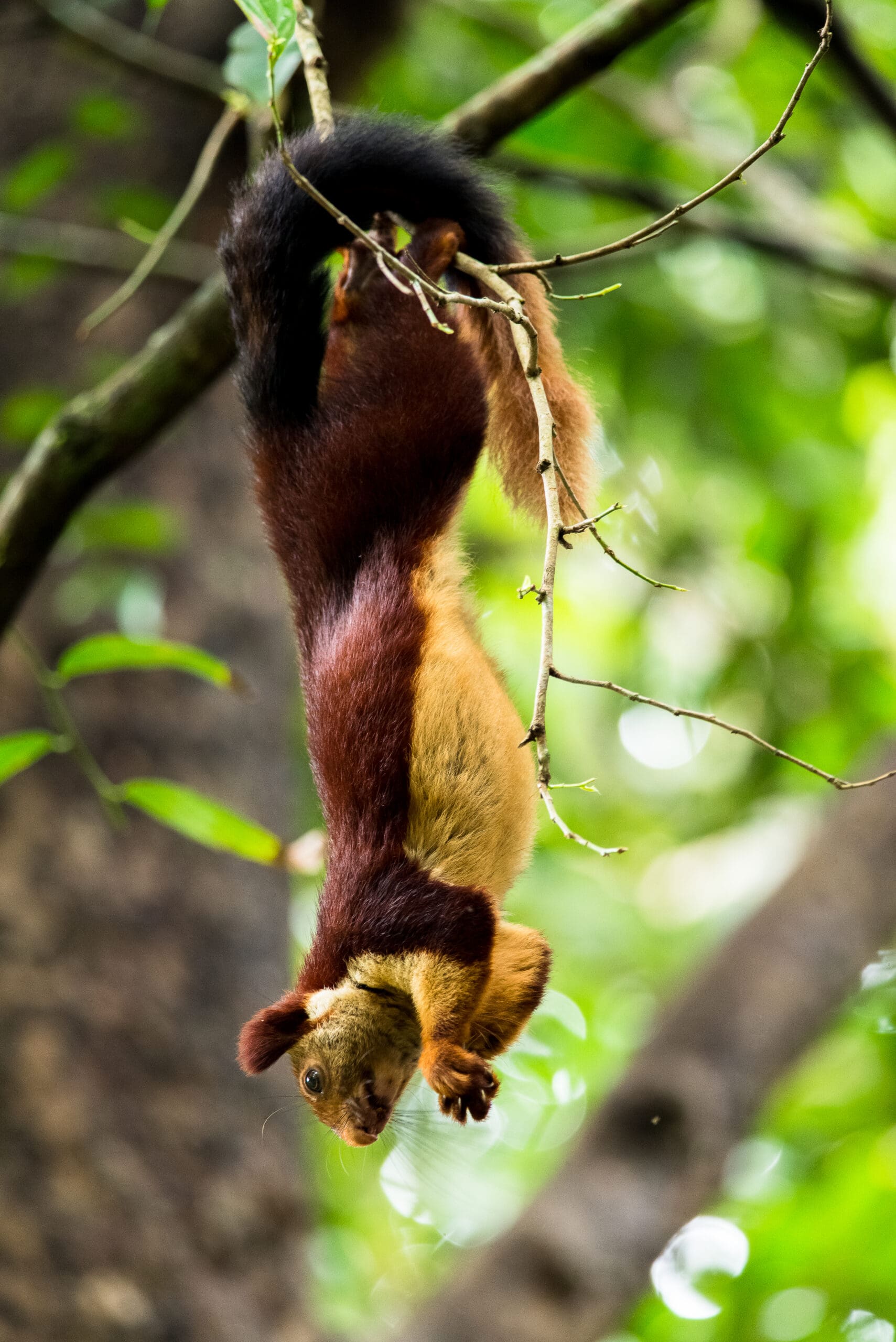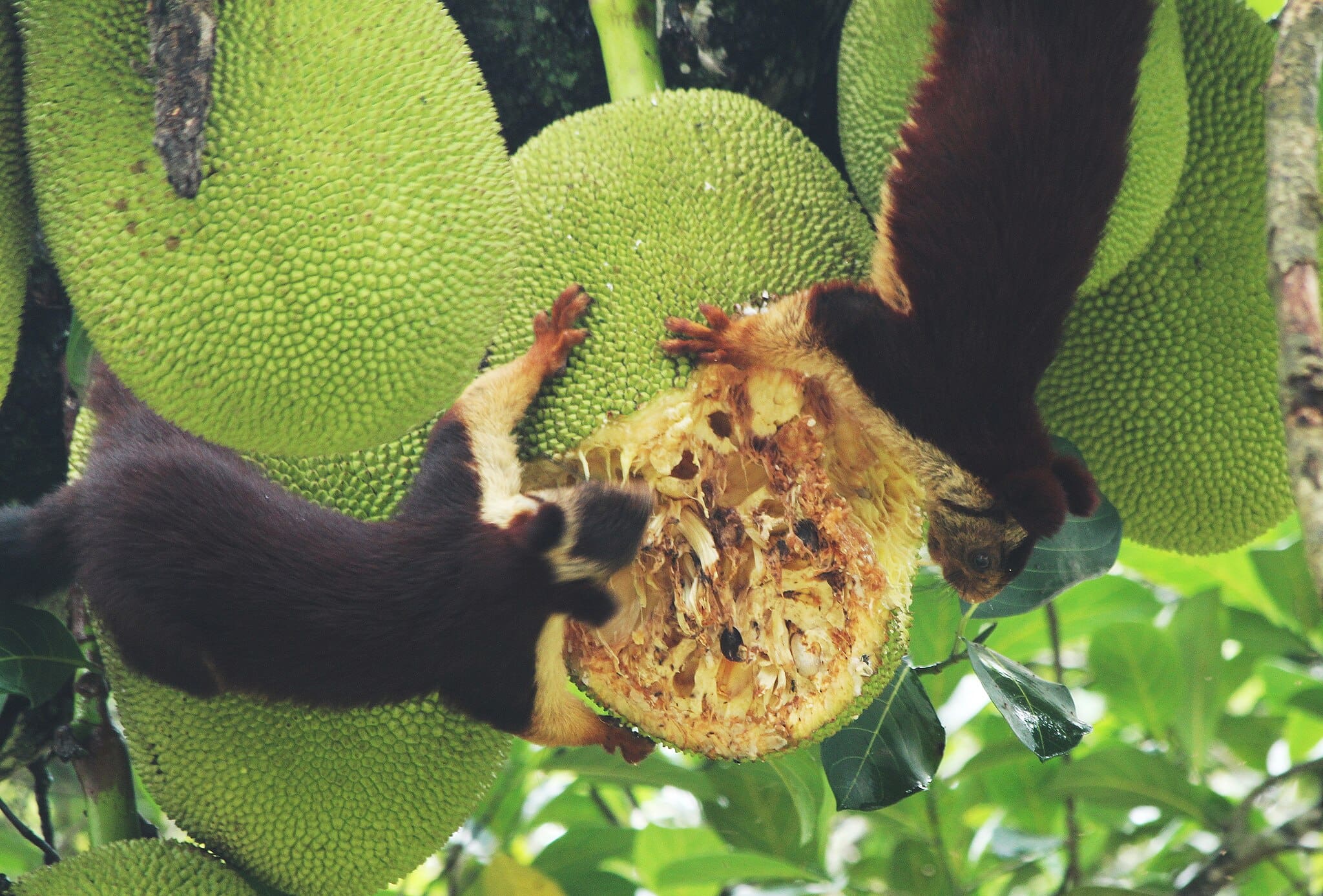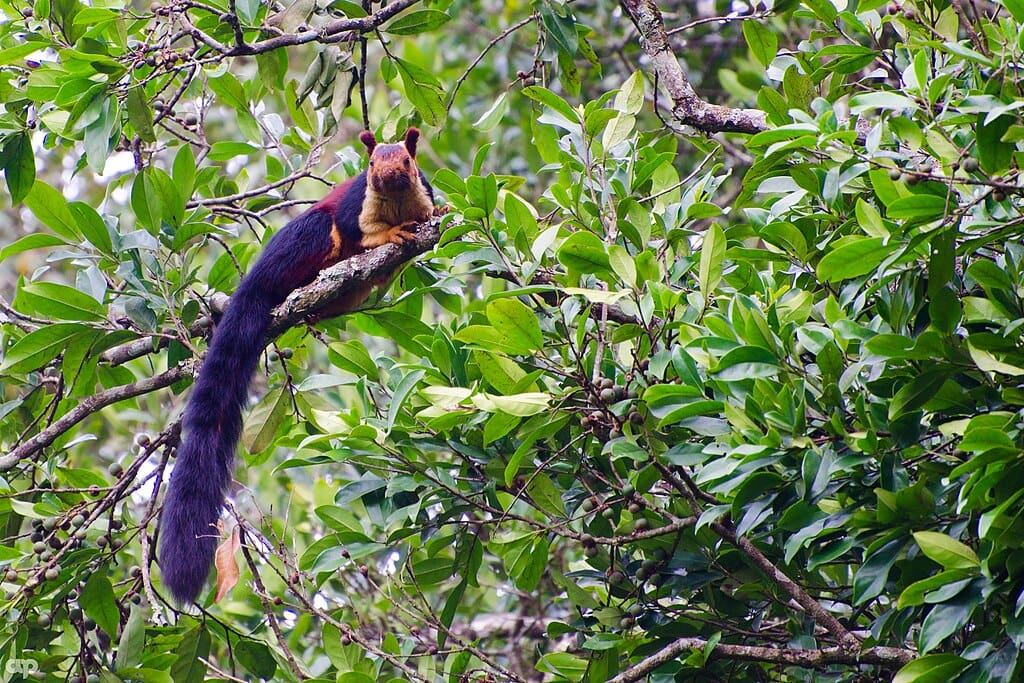I bound through the trees with a colorful tail,
From maroon to cream, I dazzle the trail.
By day I’m alone, high up in the air,
My nests are in branches, not down on the lair.
Who am I?

I was walking down a small road in Ooty, India, gazing up into the thick tree canopy above. A frantic pursuit scene was unfolding above me. Two Malabar giant squirrels appeared determined to settle a dispute between themselves. In terror, one started scrambling up the tree, and a bigger one was immediately behind it. The first one scrambled up and called frantically.
I assumed it was done as it approached the end of the branch, with seemingly nowhere else for to go. But I needn’t worry. The smaller squirrel flew through the air towards a nearby tree with complete assurance, snatching the nearest leaf it could find and dragging itself up higher into the canopy. The bigger squirrel watched its prey’s acrobatic escape with focused intensity from its perch in the first tree. As the squirrels screamed at one another, I smiled at what I can only assume were traded insults only they could understand.
The word “squirrel” has its origins in the Greek skiouros, meaning “bushy tails.” These relatively small rodents are members of the same family that includes mice, rats, and porcupines. They are further divided into tree squirrels, ground squirrels, and flying squirrels. But today we’re going to meet the three giant squirrels swinging above and scurrying about India.
The Giants of Ratufa
Giant squirrels are members of the genus Ratufa. These include the Indian Giant Squirrel (also called the Malabar Giant Squirrel), the Black Giant Squirrel, and the Grizzled Giant Squirrel. While small species like the Indian Palm Squirrel weigh in at about 100 grams, giant squirrels can weigh up to a kilogram or more.
Like other squirrels, all three giant squirrels have prominent incisors that help them feed on large fruits and break apart rough surfaces like bark. They prefer forests with well-branched trees to build nests. Each species has a distinct habitat preference: the Indian Giant Squirrel inhabits evergreen and semi-evergreen forests; the Black Giant Squirrel prefers montane evergreen and dry deciduous forests; and the Grizzled Giant Squirrel resides in riverine montane forests.
The Indian Giant Squirrel is endemic to India, commonly found across India’s heavily forests mountain ranges, especially the Western Ghats and Eastern Ghats and Satpura ranges. In fact, it is the official state animal of Maharashtra, where it is affectionately known as “shekru” and appears in educational materials and forest department campaigns. Cultural reverence like this offers a valuable entry point for community-led conservation efforts focused on forest protection and species awareness.
These squirrels display stunning coat variations: burgundy, maroon, black, and cream, with darker individuals more common the further south you go, particularly in the Anamalai Hills of Tamil Nadu. Lighter-colored squirrels are more often seen in northern parts of their range, like Maharashtra. The variation may serve a camouflaging function, helping individuals blend into the dappled light and differing forest canopies across their range, though the full ecological significance is still being studied. But even before you spot those vibrant coats, you’re certain to hear them first. Picture this: you’re walking through the shaded understorey of one of these forests, surrounded by towering Dipterocarpus trees, Syzygium saplings, and a tangling of liana vines overhead. The hush of the forest is suddenly broken by a high-pitched, staccato chirrup from the canopy. You’d be forgiven for mistaking it for the rat-a-tat-tat of a child’s toy gun. Indian giant squirrels are among the more vocal canopy mammals. Their alarm calls, like the one you hypothetically just heard, can alert other arboreal species, such as bonnet macaques or Nilgiri langurs, to the presence of predators in the area. In this way, the squirrels help support a broader web of canopy vigilance, and their vocal activity adds to the forest’s acoustic complexity.

Built for Life in the Canopy
All giant squirrels are diurnal, like you and I. They (usually) sleep through the night and are most active during the day. Though generally solitary, they occasionally feed together. Each animal typically claims its own branch for eating. Disputes over food are usually resolved without much commotion, but as we saw earlier can certainly escalate into a dramatic clash of size and wits.
While inherently timid and cautious, they have been known to occasionally snatch food from pilgrims along woodland trails to the Tirumala temple in Andhra Pradesh. While certainly not ones to turn down an easy meal, they do largely prefer the quieter life among the trees, an environment these acrobatic climbers are perfectly built for. With large, powerful claws, they grip bark and branches easily. They often hang by their hind legs while feeding and use their bushy tails for balance. They favor contiguous forest patches with tall trees and canopy connectivity, which protect them from predators and ensure food supply. Here, they build large, round nests using a mix of leaves, twigs, and bark fibers. Their trees of choice often include tall, spreading species such as Terminalia paniculata, Mangifera indica (wild mango), and Artocarpus hirsutus (wild jack). Each squirrel often builds multiple nests within a territory, using some for sleeping, others as lookouts or hideaways from predators, reflecting, I think, their deep reliance on intact forest cover.

Arshad.ka5, (CC BY-SA 4.0)Giant squirrels primarily feed on fruits, flowers, seeds, leaves, and bark. Like other rodents, their continuously growing incisors must be kept in check, so they often nibble on tough materials like tree bark and nut shells.
By feeding on and dispersing seeds, they contribute to forest regeneration. Their foraging habits help maintain tree diversity and structure, playing a crucial role in ecosystem health. While feeding on fruits from species like Ficus, Cullenia, and Syzygium, they often drop or throw away uneaten seeds, facilitating natural regeneration. This passive behavior punches above its weight, contributing to plant diversity and forest structure, especially in more fragmented habitats.
Onward and upward
Despite their wide distribution, the Indian Giant Squirrel faces growing threats. Habitat fragmentation, deforestation, and human disturbance are pushing some populations toward local extinction. Those calls we talked about earlier are a key way to locate them, and they’re getting harder to hear in many forests.
Because they depend on large, old-growth trees and dense canopy connectivity, Indian giant squirrels are considered ecological indicators; their disappearance from an area can signal declines in habitat quality or fragmentation. Conservationists use their presence as a proxy to assess the health of forest ecosystems in the biodiversity hotspots we’ve covered here, like the Western and Eastern Ghats.
Habitat conservation, protection of some of the specific trees I’ve mentioned, and reducing human interference are critical to reversing their decline. As charismatic symbols of India’s forests, these bushy-tailed giants deserve both admiration and protection.
Sri Mayilswami is an environmental researcher and consultant based in Tamil Nadu, India, with expertise in ecological risk assessment and the impacts of emerging contaminants on human and environmental health. During her PhD, she focused on evaluating environmental stressors such as chemicals, land change, and climate change. She currently leads PET India, an environmental consultancy based in Coimbatore, which applies innovative remediation technologies to tackle pollution across key sectors.
Dig Deeper
- The Giant Squirrels Of India
- Giant Indian Squirrel: A Colorful Forest Gem
- Population density and nesting behaviour of Indian Giant Squirrel Ratufa indica (Erxlebeln, 1777) in Bhimashankar Wildlife Sanctuary, Western Ghats of Maharashtra, India
- How preserving forests could save the Indian giant squirrel


